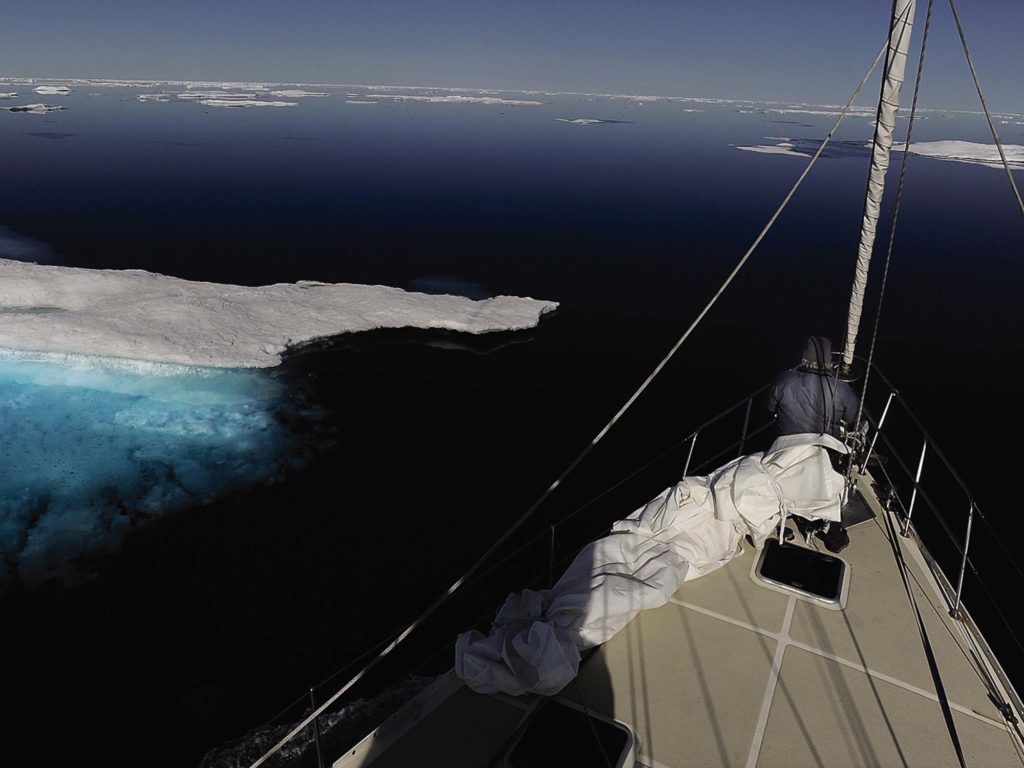
We were tucked in behind the reef to windward of our anchorage in the Grenadines’ tiny isle of Petit St. Vincent aboard my old friend John Kretschmer’s Kaufman 47, Quetzal, and it had been a wild night indeed.
In the breezy blasts of 30-knot gusts, the big superyacht just upwind of us had dragged anchor in the wee hours, and it was actually pretty comical watching its headlamped crew, their beams blinking like fireflies, scurrying about the deck trying to reset the damn thing. Come dawn, however, the unsettling view of the angry, whitecapped, deep-blue Caribbean Sea on the other side of that reef was a lot less humorous—and that’s precisely where we were bound.
Ostensibly, if incongruously considering we were closer to the equator than the Labrador Sea, we were in the midst of a weeklong jaunt that Kretschmer had dubbed “the polar navigation summit.” He’d summarized it to me in an email a couple of months earlier:
“I have a great scheme and I’d love you to be part of it. I’ve become good friends with Mark Synnott, an amazing climber and writer. He was part of Alex Honnold’s team (when he climbed Yosemite’s El Capitan without ropes), and is featured in the movie Free Solo. But he’s done incredible first ascents on his own. He summited Mount Everest and wrote a great book about it, The Third Pole. Anyway, he’s totally into sailing, and is planning to do the Northwest Passage in his Stevens 47, Polar Sun, this summer. It’s part of a big National Geographic project and super cool. While Mark is tough as nails and really smart, he needs more sailing experience and certainly more navigation experience, especially high-latitude stuff.
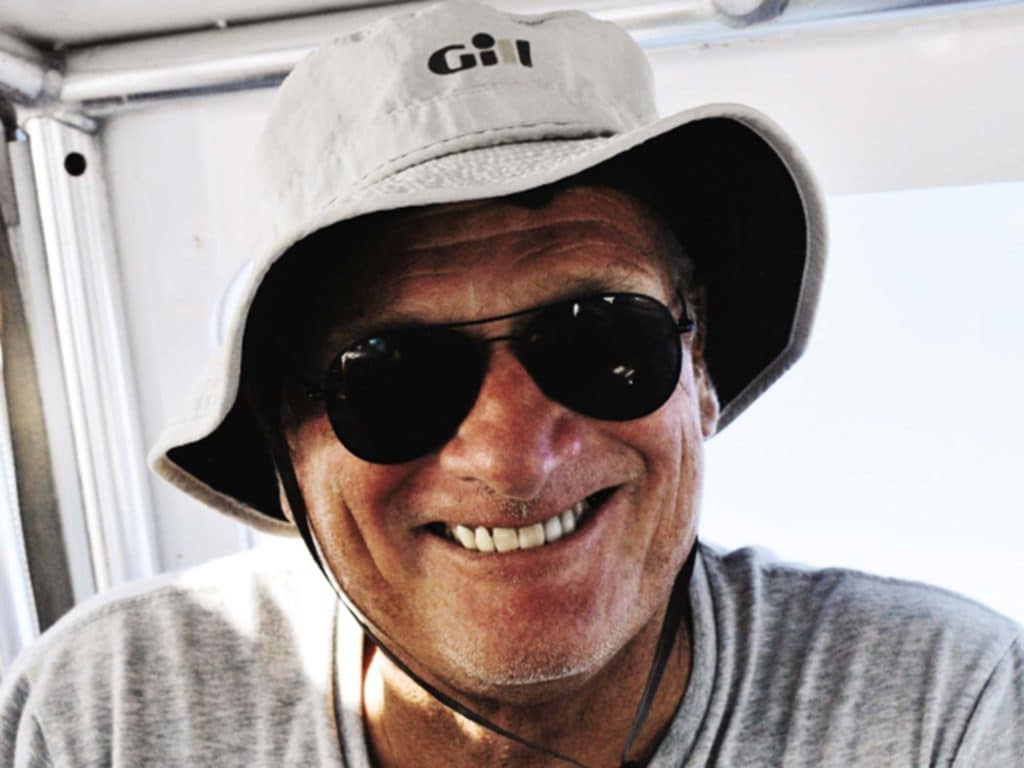
“I’ve also become friends with Porter Fox, another great writer. His latest book is called The Last Winter. It’s a beautifully written story of Northern travels and climate change, and is terrifying and poetic. His dad was Crozer Fox, who founded Able Marine and later sold it to Tom Morris. Anyway, he has a beautiful Whistler 32 and is contemplating a long voyage with his family but wants to sail aboard Quetzal for some experience, or at least spend some time aboard chatting about the ocean, climate, life, etc.
“So, here’s the proposal. It’s crazy, but I was thinking of having you three join me aboard Q in Grenada, the perfect place for a polar voyaging and navigation summit meeting—straddling the 12th parallel! I am not sure what will unfold, but some thoughts on ice and navigation—Neptune knows you know a lot about that—some thoughts about serious passagemaking, some good trade-wind sailing, some drinking, some scheming, some talk of climate and of the North, just a boys’ polar navigation summit. It’s crazy but will be a great time. I kind of see this summit as a couple of old dudes like us sharing what we know, or think we know, with some ‘youngish’ bucks.”
As a veteran of the Northwest Passage, it appeared (somewhat laughably) that I was the supposed “Arctic expert.” A superb writer and author himself, Kretschmer’s main business is running offshore training voyages aboard Quetzal, and he had a big summer voyage lined up to Greenland, Iceland, the Faroe Islands and Norway, hence his interest in getting into his own high-latitude mindset.
During the pandemic, with his usual alluring, distant destinations off-limits, Kretschmer had kept his operation going by conducting offshore trips to waypoints (not landfalls, but “sea falls”) he’d set a few hundred miles off the US Virgin Islands (which were still accessible) on round-trip instructional voyages of several days’ duration that he’d jokingly dubbed “reaches to nowhere.” He’d included a briefer one in the itinerary of our trip.
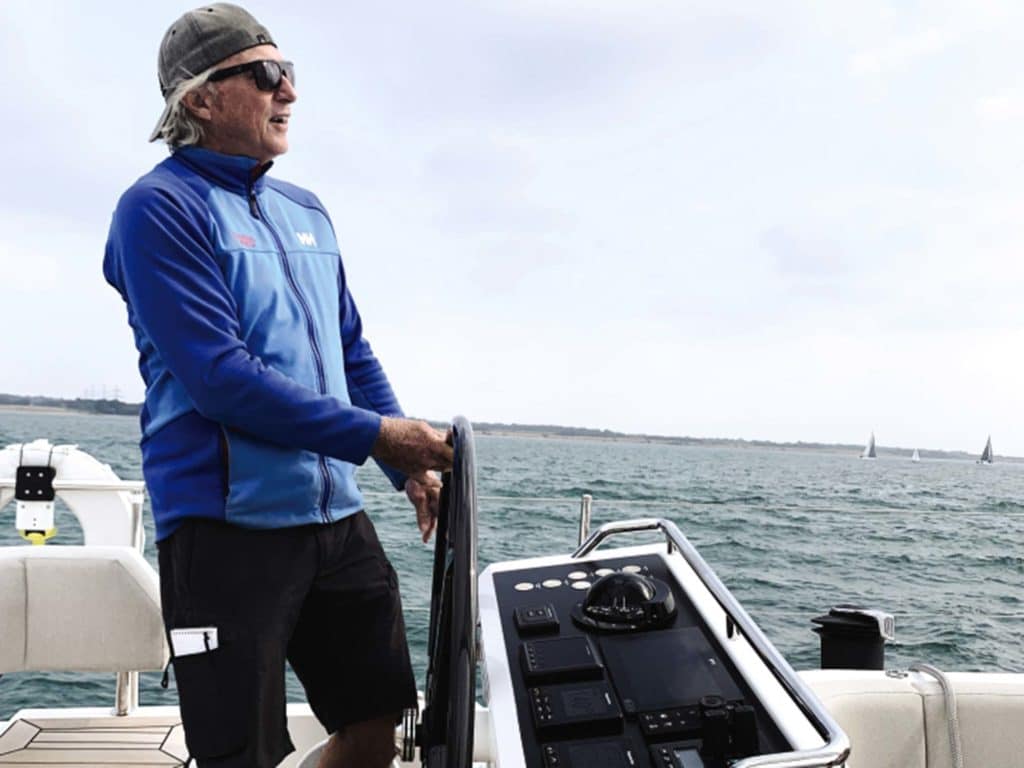
It all sounded great in his email, and we’d had a good time sailing north to Petit St. Vincent from our meeting point in Grenada. But after upping our own anchor and plowing into the staunch easterly trades for an hour or so—the offshore “nowhere” segment of our summit now underway—I was beginning to rethink the entire enterprise.
Still on the relatively shallow inshore shelf fronting the Grenadines, the motion on board was quick and violent, and for the first time in quite a while, my mouth was suddenly very dry, the rising sweat on my brow was cold and damp, and my tummy wasn’t feeling so swell. Which is when the rather unsettling question regarding my suddenly shaky sea legs came to me: Son, it’s been some time since you’ve been offshore, hasn’t it?
As I waited in the customs arrival line at the airport in Grenada, it was quite clear that the very fit cat ahead of me was none other than the accomplished Synnott, also recognizable from the jacket photo of his bestseller The Impossible Climb, an excellent book that combines simultaneous accounts of Honnold’s famous ascent with a memoir of Synnott’s own career on cliffs and mountains. We made our acquaintances and shared a cab to Quetzal’s slip at the Port Louis Marina in St. George’s, where we were greeted by our shipmates for the week: Kretschmer, Fox and Nathan Zahrt, Kretschmer’s young protégé who also conducts training trips on his Compass 47, Ultima.
Seeing as how we had gathered for polar discussions, the talk quickly turned to “the ice.” As in, we required some for the rum. And with that, the storytelling portion of the summit was underway.
Kretschmer is a master, and had some wild COVID-era tales to spin about his recent travels; Synnott was equally entertaining. His climbing remembrances were pretty crazy—his yacht, Polar Sun, is named after the nearly 5,000-foot Polar Sun Spire on Baffin Island in Canada, on which he lived for 39 days while scaling its sheer face. But he had some fine and outlandish sailing stories too.
The best was the time back in 2005 when he convinced National Geographic to sponsor a climbing expedition to remote Pitcairn Island in the southern Pacific Ocean, where many inhabitants are descendants of the HMS Bounty mutineers. This expedition required chartering a 66-foot yacht with a churlish Australian skipper to sail from French Polynesia with his team, providing several misadventures. Plus, the “climbing” on the shaky, volcanic peaks of Pitcairn was not exactly like summiting Everest; his editors weren’t exactly thrilled with the photos of everyone playing badminton on a reef. But the trip’s magical moment happened when he was standing a night watch by himself with the moon reflected in the shimmering Pacific Ocean. Bam! That’s when the sailing bug bit. And now, on his own boat, he was heading north, to Baffin and beyond.
The next morning, understandably, our collective crew was not exactly moving with vigor or dispatch. But we rallied quickly. Once the coffee kicked in, we had sails to hoist.
Kretschmer had laid out a course some 20-odd nautical miles to the north for the popular anchorage of Tyrell Bay on Carriacou; according to the notes on its noonsite.com webpage, the island was first settled by the indigenous Caribs, who called it Kayryouacou, meaning “land of the reefs.”
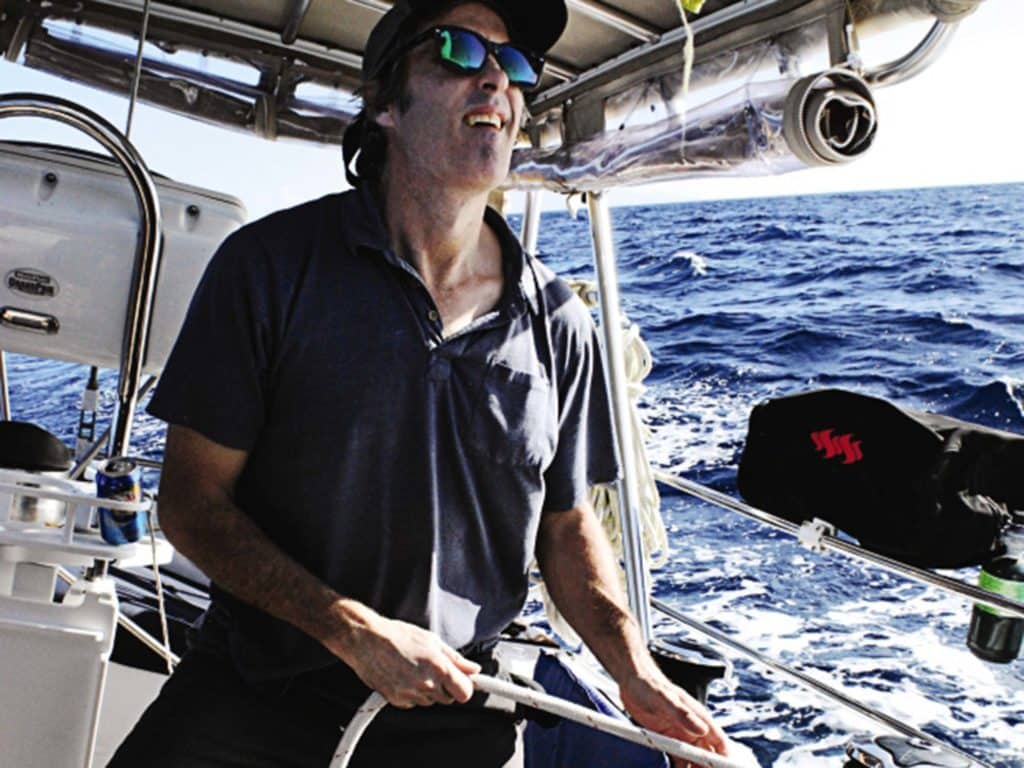
At the outset, ambling up the leeward coast of Grenada with a full main, staysail and genoa, we were sheltered from the easterly trades right up until clearing the hilly island’s north shore, at which point the easterlies commenced pumping. Time to shorten sail.
Kretschmer had promised us a bit of a sailing clinic, and our first lesson was his preferred style of reefing: bearing off to a comfortable reach at a wind angle of 110 degrees (as opposed to going head to wind, like many textbooks advise) and simply dropping the main and tucking in the reef(s). It was a gentle, no-drama maneuver, with the added benefit that we didn’t need to drop the genoa to accomplish it. Duly noted.
After the long beat to Tyrell and a nice dinner with a dash of red wine, it seemed we’d be having a more restrained, mellow evening…right up until Kretschmer fatefully unscrewed the cap on a bottle of scotch. More stories, perhaps some even truthful, were dispensed.
The next morning, we hired a cab for a nice tour of the island and to search for Kretschmer’s acquaintance who was building a schooner on a beach, the subject of the documentary Vanishing Sail. Alas, when we rolled down the hill to the purported building site, the hearty ship was complete and at anchor. However, we did chat up some locals constructing a very cool workboat nearby, then got underway for Petit St. Vincent, tucked around Carriacou’s northeast flank. Other than Kretschmer nearly drowning me in the early going on an exercise demonstrating tethers and man-overboard situations (see “Tethers and Other Matters” below), it was a pretty routine, ho-hum day.
Check that: It was a fantastic one, with absolutely killer sailing. Quetzal is named after the sacred birds of the Mayans, and is synonymous with the notion of freedom. “It’s one of the few animals that refuse to live in captivity,” said the skipper, another being who pretty much refuses the same. The boat was built in Taiwan in 1987, and Kretschmer has put in countless miles, in the six figures, aboard it. He keeps it in Bristol fashion; after all, it’s responsible not only for his livelihood, but also for his life. With its longish fin keel and skeg-hung rudder, it absolutely hauls the mail and is a flat-out gas to drive in staunch winds and rising waves, the helm always responsive and forgiving.
I was happy to let the other guys steer until Kretschmer asked, “You want a go?” I couldn’t say no, my sole task for the next couple of hours or so keeping the telltales streaming aft while tacking to weather past Palm Island and Union Island and right into the paradisiacal isle of Petit St. Vincent, the steering as light and balanced as could be. Sorry, guys, but once I got hold of that wheel, there was no way I was going to relinquish it.
Nowhere:
That was our next destination. The original plan had been to reach offshore for 50 or 60 miles, heave-to for dinner, then jibe and enjoy another reach back to Grenada. But that had been predicated on an expected northeast flow to the trade winds. What we actually encountered was solid wind hammering directly from the east, which meant a more southerly heading toward Trinidad and, gulp, Venezuela, which these days is no place anybody wants to be. That meant closehauled sailing as we broke into open water. Which led to my brief, sweaty and, thankfully, passing moment on the verge of blowing lunch.
Luckily, as we sailed into deeper water, I got back into the old familiar rhythm of being at sea. Like riding a bike, my friends, you never forget.
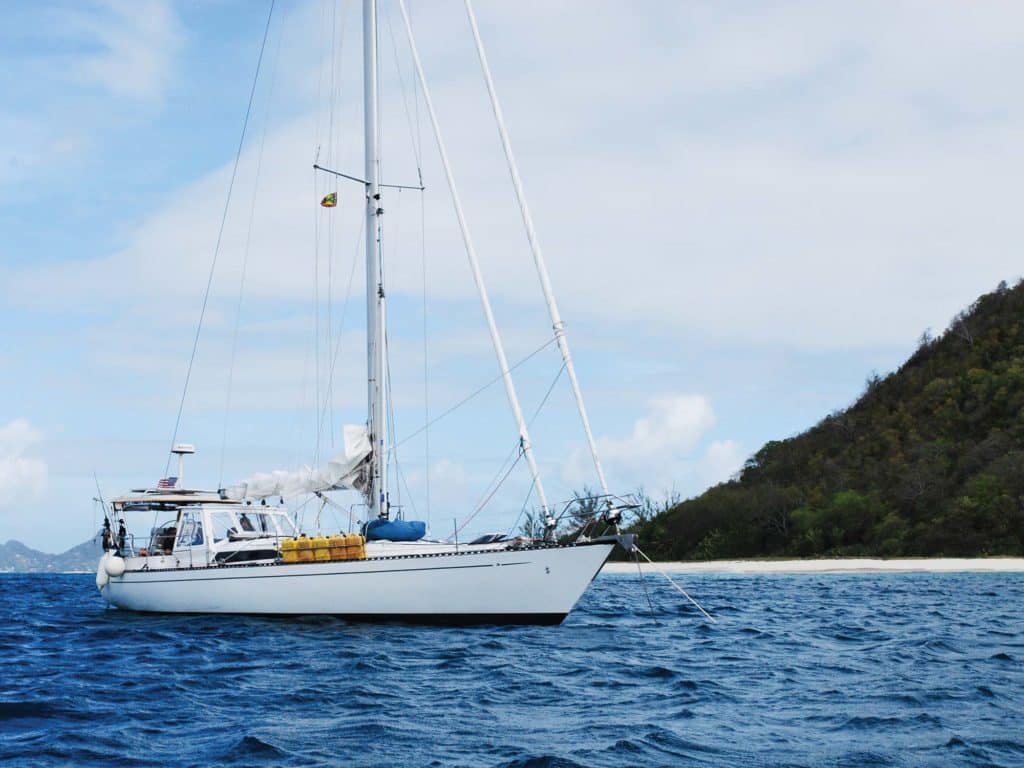
And then we were ocean sailing. Conditions were squally and sporty, to say the least; those overnight 30-plus-knot gusts had not dissipated. But the cutter-rigged Quetzal was most certainly in her element, trucking along at an easy 7 knots under a shortened-sail combo of double-reefed main and staysail. Kretschmer kept an attentive eye on the compass. “I think we’re going to end up more south than we think,” he said prophetically.
He also was a nonstop fount of information: “On port tack, as we are now, all the loads are happening from left to right, so maintain your situational awareness. Right now, anything bad that happens will happen to starboard.
“When any sort of issue arises, bear off. When the wind angle changes from 60 degrees to 100 degrees, everything levels off and the loads are lessened across the board. Your whole world changes.
“If you detect water down below, tack. It has to be coming from the low side. It buys you time and will probably expose where the problem is. It can be hard to find where the ingress is.
“These are beautiful waves. Long, long waves. Feel that temperature drop a little bit? That means we’re about to get popped by a squall. Bear off a bit. We’ll drop down to 80-degrees apparent and sail right around it.”
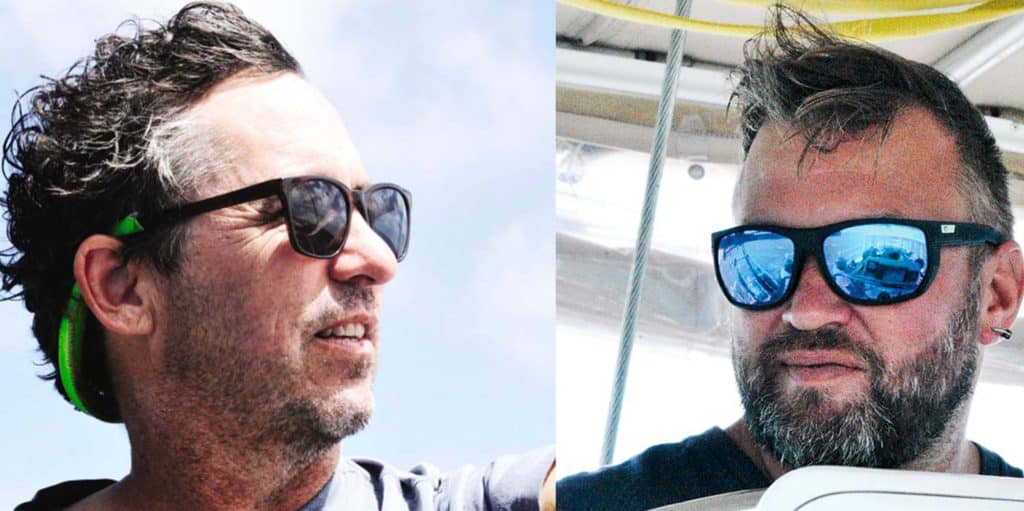
To get my attention at one point when I was driving, Kretschmer suddenly appeared from below and tossed something over the side. “Man overboard!” he cried. We’d practiced the old quick-stop maneuver the day before, after I’d sputtered back aboard following the tether drill, and I once again immediately put the bow head to wind, jibed, and luffed up right next to it. To be honest, I was surprised it worked as well in the open sea. We heaved-to, and Kretschmer pointed out the defined slick to weather, settling the seas as Quetzal calmly bobbed among them. Yet another set of experiences to etch in the memory bank.
A pretty sunset punctuated the eventful day, and with no moon, at roughly 11 degrees north, the Southern Cross and North Star both magically appeared, in all their celestial glory. It was indescribably beautiful. Kretschmer served up a fantastic chicken dinner that had been percolating all afternoon in the pressure cooker. Life was damn good.
At midnight, we spun the boat around back toward Grenada, some 45 nautical miles from our real destination: Prickly Bay on the island’s southeastern shore, a well-known hangout for cruisers from near and far.
The squalls kept coming. Kretschmer and I stood the first watch of the new day, to 0300, shooting the breeze while dodging the weather. In an offhand remark, he mentioned that he’d conducted 153 training voyages on Quetzal.
Make that 154, I thought.
We dropped Quetzal’s hook at precisely 0730 after one final rip-snorter of a dawn squall, which I had the honor of negotiating. The resulting rainbow right as the anchor grabbed made for a storybook ending to our unique summit.
I’d successfully been “nowhere” with a great group of characters. And now I want to go back.
Herb McCormick is a CW editor-at-large. For more info on John Kretschmer’s books, seminars and voyages, see his website. To track Mark Synnott’s voyage aboard Polar Sun, visit his website.
Tethers and Other Matters
A professional sailor and writer who has knocked off seven sailing books in his “spare time,” John Kretschmer has nearly 400,000 offshore miles in his wake, including 26 trans-Atlantic crossings. Along the way, he’s come to many conclusions and beliefs about “safety and seamanship,” which he says equate to one and the same. Near the top of that list are tethers—the leashes that connect one from a harness or life jacket to a jackline, with the vested goal of keeping one aboard and alive—and the right and wrong ways to employ them.
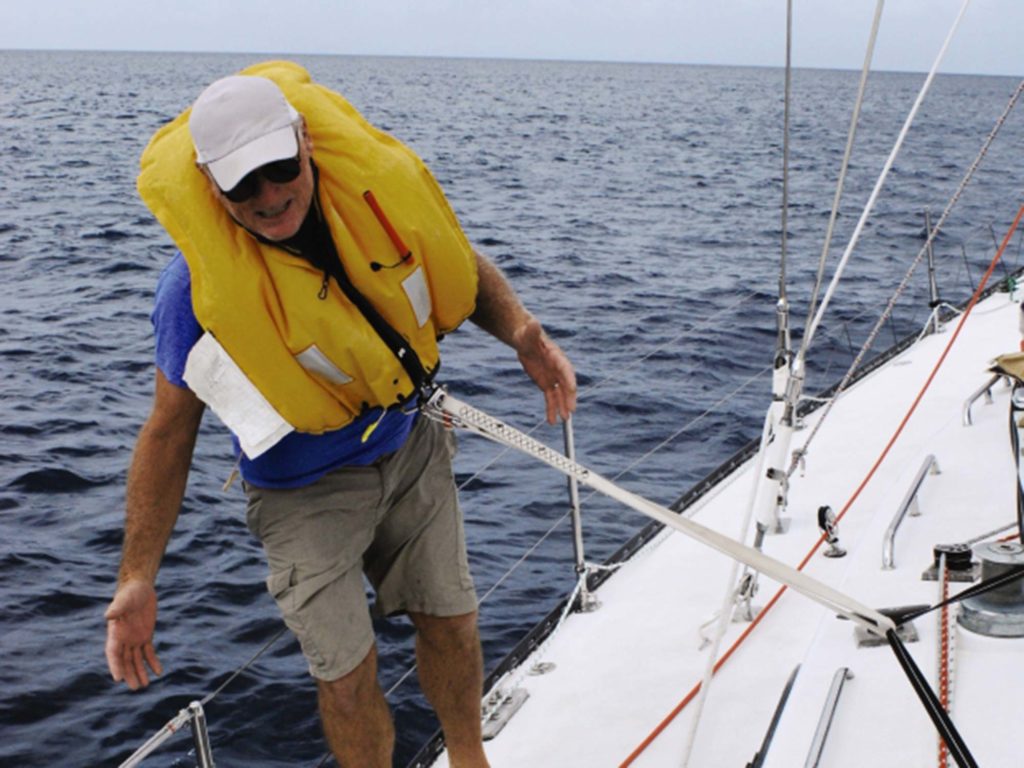
As he would on a dedicated training voyage, Kretschmer tugged on an inflatable life jacket and reviewed its operation, including manual inflation. He then made his way toward the bow, reciting the key points as he went: Always go forward on the high side of the boat. Keep your center of effort low. Take your time; in rough weather, when moving to the mast, two settled minutes is better than 10 frantic seconds. If you’re feeling shaky, sit down and regroup. Don’t hook into the lifelines; think of them as an electric fence. Do not clip into the jackline continuously; instead, clip and unclip, moving purposely to where you’re going, and then clip in. And above all else, do not use a tether too long, one that will allow you to go into the drink if you go overboard. If you do, make sure the tether has a dedicated quick-release fitting, and that you know how to use it.
To get his point across, Kretschmer gave us all too-long tethers and sent us over the side. Time for a drill.
Mark Synnott was first, his vest inflating on contact with the water. Being the athlete and climber that he is, as the boat bobbed along, not making way, he hauled himself back aboard. But Kretschmer’s point wasn’t about what happens when a boat is standing still; it was about when it’s underway, as it would be in any oceangoing situation. Synnott jumped back in, and Kretschmer instructed Nathan Zahrt, at the wheel, to put it in gear and throttle up: 1 knot, 2 knots, 3. And it was suddenly very clear that movement through the water introduced a whole new dynamic. At 4 knots, Synnott had had more than enough, pulled the quick-release shackle, and swam back to the boat. Porter Fox was next, repeating the sequence.
Then it was my turn. I consider myself a good ocean swimmer and a competent seaman. I like to think that I know what’s up when I’m sailing and when I’m in the water. But once in the sea, at 2 knots at the end of the tether, I was pretty uncomfortable. At 3, I felt the first surge of panic. At 4, I was underwater and thrashing, signaling that I was in distress just before pulling the rip cord. What the hell would it be like being dragged at 5 or 6 knots, as you would be on any actual passage if you tumbled overboard? The answer was clear and unnerving.
Kretschmer’s point was made. Short tethers. Considered movements. And the most important lesson of all: Don’t go over the bloody side in the first place.








